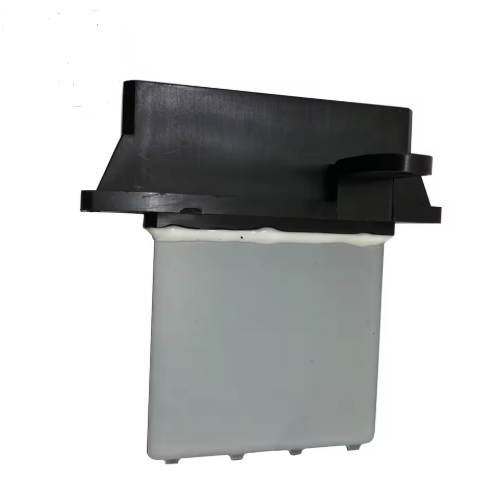Გაიგეთ საბურავო მოტორის რეზისტორის ფუნქცია ავტომობილის გათბობა-გაგრილება-განიერების სისტემებში
Შესავალი საბურავო მოტორის რეზისტორში და მის ძირითად დანიშნულებაში
Ბლოუერის მოტორის რეზისტორი მსგავსია ტრაფიკის კონტროლის მოწყობილობისა სატრანსპორტო საშუალების გათბობისა და გაგრილების სისტემებში. ის უზრუნველყოფს სხვადასხვა სიჩქარის რეჟიმებს მხოლოდ სრული დატვირთვით ან საერთოდ გამორთული რეჟიმის ნაცვლად. იგი მდებარეობს ხელსაწყოთა დაფის სამართველებსა და მოტორს შორის, ეს კომპონენტი მუშაობს გადასვლით დენის რაოდენობის რეგულირებით, რაც ცვლის სიჩქარეს, რითმით რომელითაც ჰაერი შედის სალონში. მთავარი მიზანია მძღოლებს მიეცეს სასარგებლო არჩევანის შესაძლებლობა მათი სატრანსპორტო საშუალების გამოყენებისას მშვილდის ზაფხულის სიცხეში ან მკაცრი ზამთრის დილებზე.
Როგორ ხდება ჰაერის ნაკადის რეგულირება ბლოუერის მოტორის რეზისტორის მეშვეობით მიკროკლიმატის კონტროლში
Ბრუმბის სიჩქარის გატესვის რეგულირება ხდება ელექტროენერგიის დინების შეცვლით რეზისტორის შიდა გამტარ სადგურებში. ქვედა პოზიციებზე, დენი გადის მეტი წინაღობის კოჭების მიხედვით, რაც ამცირებს ძრავის ძაბვას და ჰაერის მოძრაობის მოცულობას. როდესაც ვინმე ამაღლებს სიჩქარის პოზიციას, ის გადახტება ზედმეტი წინაღობების ზემოდან და სრული ძაბვა გადაეცემა პირდაპირ ძრავს. ამ სისტემის მუშაობის საშუალებას აძლევს წინაღობის ამ სტუპენოვანი მეთოდი. რთული ელექტრონული კომპონენტების გამოყენების ნაცვლად, ის იღებს სტაბილურ ენერგიას კედლის გამოსასვლელიდან და წინაღობის დამატებით ან ამოღებით ქმნის სხვადასხვა დონის ჰაერის ნაკადს.
Ბრუმბის ძრავის სიჩქარის კონტროლის ელექტრო პრინციპები
Ომის კანონი სისტემის მუშაობის საფუძველს წარმოადგენს (ძაბვა ტოლია დენის გამრავლებული წინაღობაზე). როდესაც წინაღობა იზრდება, დენის ნაკლები რაოდენობა ხვდება ძრავას. წინაღობის მოდულების უმეტესობას შიგნით რამდენიმე სახის გარშეული გააჩნია, რომელიც სულ მოწოდებულია წინაღობის მნიშვნელობით ნახევარი ომიდან ხუთ ომამდე. ასეთი კონფიგურაცია ჩვეულებრივ იძლევა სამიდან ხუთ სხვადასხვა სიჩქარის რეჟიმს დამოკიდებულებით მომხმარებლის მიერ არჩეულ პარამეტრებზე. ასევე შედგენილია თერმო დამცავი ხარისხები გადახურების პრობლემების საწინააღმდეგოდ. მიუხედავად ამისა, მექანიკოსების მრავალი ახსენებს, რომ ძველი ავტომობილების მოდელები ხშირად მუშაობას ვერ ასრულებენ სისტემების გადატვირთულობის დროს, რაც დღესაც არის აქტუალური პრობლემა.
Როგორ აკონტროლებს ბლოუერის ძრავის წინაღობა სიჩქარის რეჟიმებს
Სიჩქარის რეგულირების ნაბიჯობრივი პროცესი წინაღობის გამოყენებით
Ბლოუერის ძრავის წინაღობა მართავს ჰაერის ნაკადს საგათბობი ელექტრო წრედში წინაღობის შეცვლით. როდესაც მძღოლი აირჩევს სასურველ სიჩქარეს, წინაღობა ახდენს განსაკუთრებული წინაღობის დონის შეყვანას:
- Დაბიჯებული სიჩქარე : მაღალი წინაღობა ამცირებს დენის დინებას, შეზღუდვის მოტორის ბრუნვას ნელი ჰაერის დინებისთვის.
- Საშუალო სიჩქარით : ნაწილობრივი წინაღობა უზრუნველყოფს დენის ბალანსირებულ დინებას საშუალო ჰაერის დინებისთვის.
- Მაღალი სიჩქარე : წინაღობის გარშემო გზის მიცემა აძლევს სრულ ძაბვას მოტორზე, რათა მაქსიმალურად გაიზარდოს ჰაერის დინება.
Ეს სისტემა იყენებს მრავალწვერიან რეზისტორულ პაკეტს ან ტრანზისტორებით დახმარებულ დიზაინს იმისათვის, რომ შექმნას განსხვავებული სიჩქარის პარამეტრები და დაიცვას გათბობის, გაგრილებისა და ჰაერის გაცვლის მოდული ძაბვის შეტევებისგან.
Დაბალი, საშუალო და მაღალი სიჩქარე: თითოეული როგორ ურთიერთქმედებს რეზისტორულ წრედთან
Როდესაც სისტემა მუშაობს დაბალ სიჩქარეზე, ელექტრული წრე დენს ატარებს ყველა ხელმისაწვდომ გამტარ კოჭაზე, რაც ქმნის მაქსიმალურ წინაღობას, რომელიც ამ სისტემებში გვხვდება, სავარაუდოდ 3-დან 5 ომამდე. როდესაც სიჩქარე იზრდება საშუალო დონემდე, სიტუაცია იცვლება. ამ ეტაპზე სისტემა აქტიურობს ნაკლებ კოჭას ან ირჩევს სრულიად განსხვავებულ გზებს, რაც არამდრულად ამცირებს წინაღობას დაახლოებით 1-დან 2 ომამდე. მაღალი სიჩქარის მუშაობისას, უმეტესი დიზაინი უბრალოდ აერთებს ძრავას პირდაპირ ბატარეის ძაბვის წყაროსთან, სრულიად ავლით გამტარების გარშემო. ეს მიდგომა უზრუნველყოფს მაქსიმალურ ძალის მიწოდებას, მაგრამ შესაძლოა გამტარ კომპონენტებზე დამატებითი დატვირთვა შექმნას დროის განმავლობაში. ზოგიერთი ახალი მოწყობილობა მაგაც იყენებს იმას, რასაც პულსური ძაბვის მოდულაცია ეწოდება. ეს მეთოდი საშუალებას იძლევა განსხვავებული წინაღობის პარამეტრებს შორის გაცილებით უფრო გლუვი გადასვლა მოხდეს, ვიდრე ძველ სისტემებში მოხდებოდა, სადაც ერთი ფიქსირებული დონიდან მეორეზე ხდებოდა გადასვლა.
Ძაბვის მოდულაცია ელექტრული წინაღობის საშუალებით და მისი ზემოქმედება
Ძაბვის შემცირება წინაღობის საშუალებით პირდაპირ მოქმედებს ძრავის მუშაობაზე:
- 12V სისტემები : სრული ძაბვა (14V ძრავის მუშაობისას) იძლევა ~1,500 ბრუნი წუთში
- 8–10V : საშუალო სიჩქარე (~1,000 ბრუნი წუთში)
- 5–7V : დაბალი სიჩქარე (~600 ბრუნი წუთში)
Ჭარბი სითბოს გენერირება კვლავ მნიშვნელოვან გამოწვევად რჩება, სადაც წინაღობების ტემპერატურა ხშირად აღემატება 200°F-ს (93°C) მუშაობის დროს. სითბოს მართვა სითბოს გამშვები რადიატორებით და კომპონენტების სტრატეგიული განლაგებით საშუალებს მიაღწიოთ სამსახურის ვადას 5–7 წელი ნორმალური გამოყენების პირობებში.
Ბლოუერის ძრავის წინაღობა წინა ელექტრონული მმართველი მოდულებისა: ტექნოლოგიური ევოლუცია
Წინაღობის სახელმწიფო კოჭებიდან მყარ-სტატისტიკურ ელექტრონულ მმართველ მოდულებში
Ძველი სკოლის მართვის მოწყობილობის წინაღობის მოწყობილობები მუშაობდა დახვეული სადენის კოჭების გამოყენებით, რათა წინაღობა შეექმნათ, რაც მუშაობის დროს სითბოს გამოყოფის შედეგად დააქვეითებდა ძაბვას. ახალგაზრდა ვერსიები, რომლებსაც დღეს ვხედავთ, იყენებს ნახევარგამტარიან გადამრთველებს მყარ მდგრადობის ტექნოლოგიაზე. ეს ციფრული კომპონენტები აკონტროლებენ ელექტროენერგიის დინების სიდიდეს სისტემაში დაუშვებლად მექანიკური ნაწილებისა, რომლებიც დროთა განმავლობაში გამტეხილი იქნებოდა. SAE International-ის მიერ 2023 წელს გამოქვეყნებული სატესტო მონაცემების მიხედვით, ეს გადასვლა სინამდვილეში დაახლოებით 37%-ით შეამცირა მავნე მოვლენების რიცხვი. ეს სამართლიანია, ვინაიდან უფრო მარტივ წრედებს უბრალოდ არ აქვთ იმდენი წერტილი, სადაც რამე შეიძლა დამხმარე იყოს ძველი დიზაინების მსგავსად, სადაც არსებობდა ბევრი ნაზი მოძრავი ნაწილი.
Თანამედროვე PWM-ზე დამყარებული სისტემების უპირატესობები სიზუსტეში და ეფექტურობაში
PWM სისტემებმა შეიძლება მიაღწიოს დაახლოებით 94-დან 98 პროცენტამდე ელექტრულ ეფექტურობას, რაც გაცილებით უკეთესია 65-დან 75 პროცენტამდე რეზისტორზე დამყარებული სისტემების შემთხვევაში. მათი საიდუმლო რა არის? ისინი სწრაფად ამატებენ და ამოიღებენ დენს, ნაცვლად იმისა, რომ დაკარგონ ენერგია ზედმეტი ძაბვის გავლით. მრეწველობის წარმომადგენლებმა HVAC-ში ასევე შენიშნეს საინტერესო ფაქტი, რომ ამ მყარი მდგომარეობის მოდულებმა შესაძლოა მიაწოდონ დაახლოებით 0.5 პროცენტი სიზუსტე სიჩქარის კონტროლში, ხოლო ძველი სისტემები ხშირად გადახრილია მთელ 15 პროცენტამდე გადახრით. ეს მნიშვნელოვანია, რადგან როდესაც აბაზანის კონტროლის სისტემებს შეუძლიათ მოახდინონ მოძრაობის სიჩქარის ზუსტი კორექტირება, ისინი შეძლებენ სასახლის ტემპერატურის მუდმივობის შენარჩუნებას, დაახლოებით ნახევარი ფარენჰეიტის გრადუსით მომხმარებლის მიერ არჩეული პარამეტრიდან. ამიტომ ლოგიკურია, რომ მწარმოებლები გადადიან ამ ტექნოლოგიაზე.
Შემთხვევის ანალიზი: 2020 ტოიოტა კამრის გადასვლა ციფრულ ბლოუერ კონტროლზე
2020 წელს ერთ-ერთმა მანქანის დიდმა მწარმოებელმა გაანახლა სედანში არსებული ბურთულის ძველი წინაღობის სისტემა და შეცვალა ახალი ელექტრონული კონტროლის მოდულით. დამოუკიდებელმა ტესტებმა აჩვენა, რომ ამ ცვლილებამ გააჩქარა სალონის სასურველ ტემპერატურამდე მისვლა დაახლოებით 32 პროცენტით. შემდეგი სამი წელის განმავლობაში გათბობის და გაგრილების სისტემასთან დაკავშირებული გარანტიული პრობლემების რაოდენობაც შემცირდა დაახლოებით 18%-ით. დიაგნოსტიკური ანგარიშების გაანალიზების შედეგად ინჟინრებმა დაადგინეს, რომ ელექტრო კომპონენტების თერმული დატვირთვა 72%-ით ნაკლები იყო იმ მანქანების ელექტრო ნაწილებთან შედარებით, რომლებშიც ძველი წინაღობის დიზაინი იყო გამოყენებული. ეს გაუმჯობესებები საუბრობს იმაზე, თუ როგორ შეიძლება სასრული წინაღობის სისტემებიდან გონივრულ ელექტრონიკაზე გადასვლამ შესრულებასა და საიმედოობაში მნიშვნელოვანი განსხვავება შეიტანოს.
Ხარჯები, საიმედოობა და ბურთულის ძრავის მართვის მიღების ტენდენციები ინდუსტრიაში
Ელექტრონული მოდულები აუცილებლად უფრო მაღალ ფასს წარმოადგენს, დაახლოებით 2-3 ჯერ მეტს, ვიდრე ტრადიციული რეზისტორული სისტემების საწყისი ფასი. თუმცა გრძელვადიანი საიმედოობის განხილვისას, ეს მოდულები დაახლოებით სამჯერ მეტ ხანს გრძელდება სტანდარტული რეზისტორული კონფიგურაციებზე ათწლეულის განმავლობაში. ავტომომხმარებელთა სექტორიც ამ ტექნოლოგიის მიღებას საოცრად სწრაფად ახორციელებს, წელზე წელი ზრდა კი დაახლოებით 19%-ს აღწევს 2020 წლის დასაწყისიდან. ავტომოწყობილობების მწარმოებლები ამ გაუმჯობესებების გატარებას უპირატესობას აძლევენ ძირითადად იმიტომ, რომ მათ საჭიროა უფრო მკაცრი საწვავის ეკონომიის მოთხოვნების დაცვა მსოფლიო მასშტაბით მოქმედი რეგულატორული სააგენტოებისგან. საინტერესოა, რომ ბევრი მწარმოებელი ამჟამად შუა გზას ირჩევს. ყველა ახლად გამოშვებული ავტომობილის დაახლოებით 43%-ს ჰიბრიდული კონფიგურაცია ახასიათებს, სადაც საბაზო რეზისტორები ელექტრონული მონიტორინგის კომპონენტებთან ერთად მუშაობს. ეს შერეული ამონახსნი ხარჯების კონტროლში დახმარებას უწევს ხელახლა სისტემის საერთო წარმადობის გაუმჯობესებისას, სანამ ინდუსტრია სრულად ელექტრონულ ამონახსნებზე გადავა.
Ნაკერის მოტორის რეზისტორული სისტემების დიზაინი, გრძელვადიანობა და სიგნალის გადაცემის მიმართულება
Ტიპიური რეზისტორული მოდულის შიდა კომპონენტები და კონსტრუქცია
Ნაკერის მოტორის რეზისტორული მოდული ჩვეულებრივ უზრუნველყოფს ნიკელ-ქრომის წინაღობის კოჭებს, რომლებიც მიემაგრებიან კერამიკულ ან ალუმინის გამაგრებელ რაფებს, რომლებიც მიემართებიან მანქანის HVAC სისტემას. ამ მოდულებში არსებობს რამდენიმე განსხვავებული წინაღობის გზა, რომლებიც განსაზღვრავს ჰაერის დინების სიჩქარის პარამეტრებს. ქვედა სიჩქარეებზე მუშაობისას გრძელი კოჭის სექციები იწყებს მოქმედებას, რადგან ისინი ბუნებრივად უზრუნველყოფენ ელექტროდენის გადამდებ წინაღობას. დენი განაწილდება საშენი მოწყობილობის შიგნით გამავალი სპილენძის ავტობუსების მიხედვით. კომპონენტები დაცულია ეპოქსის გარსით ვიბრაციების წინააღმდეგ, რასაც მექანიკოსები ხშირად ხედავენ. საერთაშორისო ავტომობილის ინჟინერთა საზოგადოების (SAE International) 2021 წლის მონაცემების მიხედვით, რეზისტორების დახურვის შემთხვევების ათიდან შვიდი დამუშაობის შედეგად წარმოიქმნება დაზიანებული პირობების გამო, რომლებიც გამოწვეულია ხანგრძლივი მოძრაობით და დროის განმავლობაში დატვირთვით.
Თერმული მართვის გამოწვევები და უარყოფის პროფილაქტიკა
Როდესაც მუშაობს, 6-დან 15 ამპერამდე დენს მომსახურე რეზისტორები გამოყოფს საკმარისად მაღალ სითბოს, რომლის სიმაღლე 140-დან 290 ფარენჰეიტის სიჩქარით აღწევს. ასეთი კომპონენტები ხშირად დამზადებულია ფოლადის შრომიანი საშენი მასალისგან, რომელსაც გაგრილების პირი აქვს, რაც დახმარებას ახდენს თერმული ენერგიის დაახლოებით 85-დან 110 ვატამდე გასაყინად. გავრცელებული პრობლემა, რომელიც ადრეულ გამართულებას იწვევს, ხდება მაშინ, როდესაც მტვერი აღწევს და აფერხებს ჰაერის გადაადგილებას ან კონტაქტები იკვრება და ქმნის დამატებით წინაღობას. ამ პრობლემების საწინააღმდეგოდ, ახალი მოდელები ახლა შეიცავს თერმულ დანადგარებს, რომლებიც გამორთავს დენს, თუ ტემპერატურა აღემატება 320 გრადუსს პლუს ან მინუს 15 გრადუსით. უსაფრთხოების ეს საშუალება მნიშვნელოვნად განსხვავდება ბოლო კვლევების მიხედვით, რომლის მიხედვითაც ავტომობილის მწარმოებლებმა შეამჩნიეს დაახლოებით 43%-იანი შემცირება ბლოუერის ძრავის რეზისტორების გაცვლის სიხშირეში 2018 წელს ამ ცვლილების განხორციელების შემდეგ, როგორც ეს ასახულია NASTF-ის 2023 წლის უახლეს სინახვის შედეგებში.
Სიგნალის გზა გამათბობის, გაგრილებისა და განივრის კონტროლის პანელიდან ბლოუერის მოტორის ოპერაციამდე
Თუ ვინმე აირჩევს ბლოუერის სიჩქარე 2-ს ან 4-ს სატრანსპორტო საშუალების კლიმატური კონტროლის სისტემაში, სისტემა სინამდვილეში ამართებს ძაბვის 12 ვოლტს რეზისტორზე არსებული საშუალო სიჩქარის ტერმინალის მიხედვით. შემდეგ რა მოხდება დამოკიდებულია მანქანის წარმოებაზე, მაგრამ საერთოდ ამ კონფიგურაცია ქმნის წინაღობას 2.1-დან 3.8 ომამდე დიაპაზონში. ეს წინაღობა ამცირებს ძრავასთან მიმავალ ძაბვას დაახლოებით 7-დან 9 ვოლტამდე სრული ძაბვის ნაცვლად. ელექტროენერგია შემდეგ გადადის ნახშირის ჩარჩოებზე და აღმოჩნდება ძრავის შიდა ნაწილში, რომელიც ბრუნავს დაახლოებით 1,200 ბრუნი/წუთში და აქარი სადგურების სისტემით. მაშინ, როდესაც საჭიროა მაქსიმალური ჰაერის ნაკადი, უფრო მაღალი სიჩქარის პოზიციები სრულიად ავიტარებს რეზისტორს, გადასცემს პირდაპირ აკუმულატორის ძაბვას მძღოლისთვის და მგზავრებისთვის, რათა მიიღონ საჭირო სუფთა ჰაერის დამატებითი ნაკადი ცხელი ზაფხულის დღეების განმავლობაში.
Ბლოუერის მოტორის რეზისტორის გამოყენება და ინტეგრირება თანამედროვე სატრანსპორტო საშუალებებში
Მანქანების და საკომერციო მანქანების გამდინარე მოტორების წინაღობის გამოყენება
SAE International-ის 2023 წლის ბოლო მონაცემების მიხედვით, გამდინარე მოტორის წინაღობა კვლავ ასრულებს მნიშვნელოვან როლს 2015 და 2023 წლებში გამოშვებული 8 შიდა წვაში მოწყობილი მანქანის 10-დან. ჩვენ ხშირად ვხვდებით ამ ნაწილებს იმ ბიუჯეტური მანქანების ხელსაწყოებში, სადაც ისინი მარტივად ასაშენია და არ გადახდის ბანკი. ნამდვილი უპირატესობა გამოჩნდება მძიმე ტვირთის ტრაქტორებში, სადაც ეს წინაღობა გამძლეა მკაცრი პირობების წინააღმდეგ. მათი გამძლე აგება არის სწორად გამავალი ჰაერის ნაკადი, მაშინაც კი, როდესაც ტემპერატურა მკვეთრად იცვლება გრილიდან -40 გრადუსი ფარენჰეიტიდან 248 გრადუს ცხელ ფარენჰეიტამდე. ასეთი საიმედოობა მნიშვნელოვანია გრძელი მანძილის მძღოლებისთვის, რომლებსაც საჭიროებენ სტაბილური კომფორტი კაბინაში გზაზე მილის მილის მიხედვით.
Კაბინის ჰაერის ნაკადისა და კომფორტის მართვაში მონაწილეობა
Ელექტრული წინაღობის მნიშვნელობის რეგულირება ნახევარ ომიდან ხუთ ომამდე საშუალებას გვაძლევს სასქეში მოძრავის მუშაობის სიჩქარის საკმარისად ზუსტად კონტროლის განხორციელებაზე, რაც მნიშვნელოვან როლს თამაშობს ავტომობილში ადამიანების კომფორტულ შეგრძნებაში. ამ მეთოდის გამოყენებით მიიღება სადენის მიხედვით ოთხიდან შვიდ სხვადასხვა ჰაერის ნაკადის რეჟიმამდე. მძღოლები შემდეგ იპოვიან იმ ისეთ რეჟიმს, სადაც მათ სურთ დაბალი ხმაურის მიღწევა (45-55 დეციბელი ნელი მუშაობის დროს), მაგრამ ამავე დროს საჭიროა სივრცის სწრაფად გათბობა ან გაგრილება (ტემპერატურის ცვლილება 3-5 ფარენჰეიტის გრადუსი წუთში). თერმული გამოსახულების ტესტებმა აჩვენა, რომ ხარისხიანი წინაღობები ხოლმოკლებს 300 ფარენჰეიტის გრადუსს გრძელვადიანი მუშაობის შემდეგაც, ამიტომ ჰაერის ნაკადის მუშაობაში შესრულების დაქვეითება არ ხდება.
Ავტომატური მიკროკლიმატის კონტროლისა და სენსორული სისტემების ინტეგრირება
Ახალგაზრდული ამპლუაციები ურთიერთად აერთიანებს წინაღობებსა და ციფრულ სენსორებს ჰიბრიდული კონტროლის ქსელების შესაქმნელად:
| Სისტემის კომპონენტი | Ანალოგური წინაღობის როლი | Ციფრული ინტეგრაციის სარგებელი |
|---|---|---|
| Კაბინის ტემპერატურის სენსორები | N/A | Იძლევა სამიზნე ჰაერის ნაკადის მონაცემებს |
| Ბლოუერის მოტორის რეზისტორი | Ფიზიკურად შეზღუდავს დენის გადინებას | Უზრუნველყოფს 12-ნაბიჯიან გრანულირებულ სიჩქარის კონტროლს |
| ECU | Ინტერპრეტაციას უწევს რეზისტორის პოზიციის სიგნალებს | Აწესრიგებს ჰაერის ნაკადს სენსორების მონაცემების საშუალებით |
Ეს არქიტექტურა საშუალებას აძლევს ავტომობილებს, როგორიცაა 2023 წლის Ford Transit, შეინარჩუნონ კაბინის ტემპერატურის გადახრა ±1°F, რომელიც ინარჩუნებს რეზისტორის სარგებელს სრულად ელექტრონული მოდულების მიმართ.
Ხშირად დასმული კითხვების განყოფილება
Რა როლი აქვს ავტომობილის გამახურებელი მოტორის რეზისტორს ჰაერის გაცივებისა და გათბობის სისტემაში?
Ავტომობილის გამახურებელი მოტორის რეზისტორი ჰაერის გაცივებისა და გათბობის სისტემაში აკონტროლებს ბრუნვის სიჩქარეს ელექტრო წინაღობის დარეგულირებით. ეს საშუალებას აძლევს მძღოლებს შეარჩიონ სხვადასხვა ჰაერის ნაკადის რეჟიმი კომფორტისთვის განსხვავებულ ამინდში.
Რა იწვევს ბლოუერის მოტორის რეზისტორების მარცხვას?
Ბლოუერის მოტორის რეზისტორები ხშირად მარცხავს განმეორებით დატვირთვისა და მოძრაობის გამო წარმოქმნილი დაზიანებული პინაკლების შედეგად, ზედმეტი სითბოს ან მტვრის დაგროვების გამო დაბლოკილი ჰაერის ნაკადის შედეგად. ახალგაზრდა მოდელებში თერმული დანადგარები ახმარებენ გადახურების თავიდან ასაცილებლად და დენის გასატეხად როდესაც ტემპერატურა ზედმეტად მაღალია.
Როგორ აუმჯობესებს სადგუროების PWM სისტემები HVAC სისტემის ეფექტურობას?
Სადგუროების PWM სისტემები უზრუნველყოფს გაუმჯობესებულ ელექტრულ სიმკვრივეს სიმძლავრის სწრაფი ციკლური გადართვით, ენერგიის დანახარჯის შემცირებით. ისინი სთავაზობენ ზუსტ სიჩქარის კონტროლს შემცირებული ტემპერატურის გადახრით, უფრო ეფექტურად შეინარჩუნებენ სამანქანო ტემპერატურას ძველი სისტემებთან შედარებით.
Რატომ არის ელექტრონული კონტროლის მოდულები უფრო სანდო რეზისტორებზე დამყარებული სისტემებთან შედარებით?
Ელექტრონული კონტროლის მოდულები უფრო სანდოა მექანიკური კომპონენტების არ არსებობის გამო, რაც ამცირებს მარცხვის წერტილებს. მყარი მდგრადი ტექნოლოგია უზრუნველყოფს ეფექტურ სიმძლავრის მართვას მექანიკური გასვლის გარეშე, რაც გამოიწვევს რეზისტორების მარცხვას.
Როგორ უწყობს ხელს ავტომობილის ინდუსტრიაში ბლოუერის ძრავის რეზისტორების ინტეგრაციამ ხარჯების მართვაში?
Ბლოუერის ძრავის რეზისტორების ციფრულ კომპონენტებთან ერთად გაერთიანება ჰიბრიდული სისტემის ჩამოყალიბებას უზრუნველყოფს, რაც მუშაობისა და ხარჯების ბალანსს უზრუნველყოფს. ეს აწვდის მწარმოებლებს ხარჯთაურმაგ ამონახსნს სრულად ელექტრონულ სისტემებზე გადასვლის პროცესში.
Შინაარსის ცხრილი
- Გაიგეთ საბურავო მოტორის რეზისტორის ფუნქცია ავტომობილის გათბობა-გაგრილება-განიერების სისტემებში
- Როგორ აკონტროლებს ბლოუერის ძრავის წინაღობა სიჩქარის რეჟიმებს
-
Ბლოუერის ძრავის წინაღობა წინა ელექტრონული მმართველი მოდულებისა: ტექნოლოგიური ევოლუცია
- Წინაღობის სახელმწიფო კოჭებიდან მყარ-სტატისტიკურ ელექტრონულ მმართველ მოდულებში
- Თანამედროვე PWM-ზე დამყარებული სისტემების უპირატესობები სიზუსტეში და ეფექტურობაში
- Შემთხვევის ანალიზი: 2020 ტოიოტა კამრის გადასვლა ციფრულ ბლოუერ კონტროლზე
- Ხარჯები, საიმედოობა და ბურთულის ძრავის მართვის მიღების ტენდენციები ინდუსტრიაში
- Ნაკერის მოტორის რეზისტორული სისტემების დიზაინი, გრძელვადიანობა და სიგნალის გადაცემის მიმართულება
- Ბლოუერის მოტორის რეზისტორის გამოყენება და ინტეგრირება თანამედროვე სატრანსპორტო საშუალებებში
- Ხშირად დასმული კითხვების განყოფილება

